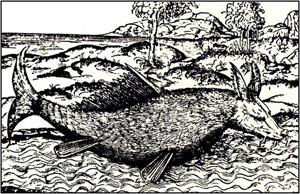 |
|||||||
Portrait
of Andura (Hoga) |
The
On Monsters and Marvels Although
the biologic link has yet to be confirmed, many feel the Andura (Hoga)
is an ancestor ot the Furbearing Trout. |
||||||
In
this book, he gave 13 reasons that cause monsters. (At
that time, word the “monster” was used to address the today’s
word “freak”.) The job of scientists at the time was not
the construction of model of the universe as is for them today. The
job of scientists in the 16th century was to discover, translate, and
understand the symbolic messages in nature sent by God. The science,
nature, magic, art, politics, and religion were one.
|
|||||||
|
|||||||
From
the book On
Monsters and Marvels |
This fish produces live offspring, in the fashion of a whale. If you contemplate it while it is disporting itself swimming in the water, you would say that it is now green, now yellow, and then, red, just like the chameleon; it keeps more to the edge of the lake than elsewhere, where it feeds on leaves of a tree called Hoga, from which it took its name. It is very toothy and savage, killing and devouring other fish, indeed [those] bigger than it is; that is why people pursue it, hunt it and kill it, because if it entered into the conduits it wouldn’t leave a single one of them alive; whereby the person who kills the most of them is most welcome. | ||||||
 |
|||||||
